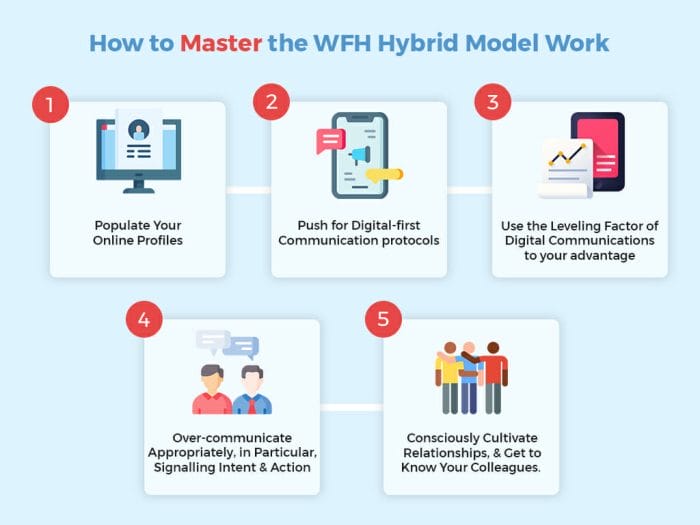So the good news is, you’ve got the go-ahead to continue to work remotely, even if others in your team are returning to a shared office environment for at least some of their working week. Everyone’s talking about ‘hybrid work’, but what is a hybrid work model anyway?
It’s a bit of a catch-all term that right now, people are using to mean different things. Various hybrid remote models are emerging, including places where:
- Everyone does some work at home/remotely and some at a central location, splitting their week or month accordingly
- People work flexibly depending on the demands of the work activity itself. Coming together for face-to-face collaboration when needed, for example, or to use specific facilities
- Some people are office-based permanently, while others are permanently remote, and rarely see one another. This may also divide out across whether the leadership team are based at HQ, or remote is a perk for senior people.
When some people have physical access and influence that others do not, there are always risks of discrimination, direct or indirect. Since the days of men-only golf courses to the executive restroom, it’s easy for structural factors to make implicit divide greater. In a hybrid setup, anyone looking for somebody to consult, promote, or involve in a decision is subject to availability biases, which often mean the person under their nose directly gets favored treatment. This has real implications for those working at a distance. And requires deliberate effort from those decision-makers to overcome it, just like any other unconscious bias.
As a remote participant, you need to be aware of this. And while you can’t control other people’s biases, you can deliberately work to overcome any lack of opportunity that your situation might provoke. You can master the hybrid remote set-up model, and grow yourself a career that supports your lifestyle plans at the same time, but it’s going to take conscious effort.
How to Master the WFH Hybrid Model Work

1. Populate Your Online Profiles in the Systems You Use at Work:
Enhance your visibility in your business communications. Ensure you have a distinct professional profile picture in your email and messaging, and that your contact information and preferences are clearly communicated. Often in lists of user accounts, those with pictures and richer profiles show higher up. For video too, good lighting and connection will make you more visible and manifest to your colleagues in synchronous communications.
If you’re a remote manager, check out this guide to know everything you’ll need to master the remote work world.
2. Push for Digital-first Communication Protocols, and Open Communications
Never put in a private email something which might be better placed in a shared channel. exemplify transparency and visibility in your work, by looping in (e.g. tagging) others who might have valuable input, wherever they are located.
3. Use the Leveling Factor of Digital Communications to Your Advantage
It might be culturally challenging for a junior executive to go and knock on the CEO’s door to share their brilliant idea. But there are no gatekeeping PAs or barriers to DMing them directly…
4. Over-communicate Appropriately, In Particular, Signaling Intent and Action
Show up, check-in — never leave anyone wondering what you’re doing or if you’re working today. Be the first to say hi in the morning and share your priorities for the day. Then connect with relevant updates throughout your work, and particularly before you log out.
5. Consciously Cultivate Relationships
But, how to cultivate relationships with your remote colleagues?
- Allowing time for some small talk/text chat, at the beginning or end of synced meetings
- Offer some information about yourself as an individual human, so people may feel more comfortable reciprocating, especially if you ask questions: Who else loved Iceland in Eurovision..?
- Experimenting with apps like Donut in Slack, for larger teams, which randomly pairs people up for chats
- Scheduling non-work meetings and virtual coffees, with no agenda other than deepening connection
Wrapping Up
If you are aware of the potential risks in a hybrid setup and dedicate a bit of time and attention to mitigating them, there’s no reason why your career cannot progress and develop — while you continue to live where and how you choose. At the same time you’ll be modeling behavior that works for the whole team, and therefore makes things better for your colleagues (especially the remote contingent). Change-makers don’t have to be in formal leadership roles, to be effective.
You’ll need to do a bit of deliberate work to overcome the structural disadvantages of a hybrid layout. But when you think of all those colleagues at HQ dashing off for the early morning commute every day, you’ll remember it’s all so worthwhile.






